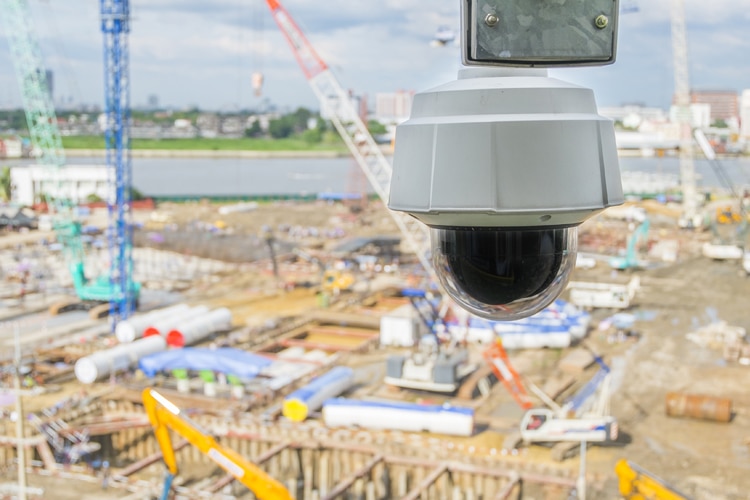For years, it was commonplace to see a lone pickup truck parked after hours at the construction site of a new apartment complex, circling the property every 15 minutes to keep an eye out for would-be copper or tool thieves. As video technology has become both better and cheaper, that stoic security presence has been augmented and supported by construction security cameras stationed around sites, keeping a watch over any areas of concern or potential theft. This emergence of on-site cameras within all build environments comes for good reason—according to the Chartered Institute of Building (CIOB), 9 in 10 construction professionals find themselves dealing with theft on a consistent basis. Reports of the construction industry losing $1B per year due to theft are also coming to light, furthering the appeal and need for construction camera systems on jobsites.
While theft became the initial catalyst for this digital visual revolution, there have been a number of ways that on-site photo and video coverage have begun to hold more value for general contractors, from fostering community goodwill to making jobsites safer.

Site Progress for Public Viewing
Imagine being able to see a whole project being built from the ground up. This, of course, is a reality thanks to well-placed construction time lapse cameras and photography that allows for any and all viewers to see exactly how a build site is coming together. In 2013, Kiewit Infrastructure, along with Wilson and Company, teamed up with the Colorado DOT for an $18M project to replace a worn-out bridge at Pecos Street across I-70. They allowed not only bleachers for the public (in a safely distanced location) but also placed jobsite cameras for the public to watch live construction camera footage of the astonishing 24-hour process of removing one bridge and replacing it with a new one, which was later condensed to a 60 second time lapse. Denver residents were able to see their tax dollars at work, and viewers of the project may even be inspired to enter the design and construction field after seeing it in action.
Jobsite Transparency
Jobsite video cameras became a crucial tool for a leading general contractor in Texas after the footage helped them win a court case. After a successful pilot program that saved $15k of warranty work, the firm had cameras mounted on unmanned aerial vehicles (UAV)—more commonly known as drones— and flew them around the site for an experimental attempt at in-depth video and photography for project progress reports. The firm got even more from the footage than they initially bargained for. After a dispute with a subcontractor made its way into the courtroom, the drones’ footage proved that the subcontractor did not actually perform the work they claimed— a different subcontractor had actually done the work, which freed the general contractor from a possible court judgment and legal fees totaling close to $500k.
Risk Mitigation
Advancements in solar power, as well as prolonged battery life, have also put construction cameras into the forefront of risk mitigation. Ensuring insurance compliance is a huge hurdle for build projects of all sizes, and having the ability to add thermal imaging for fire detection has greatly increased the value of on-site cameras. Being able to comfortably monitor even the largest of sites on a 24-hour basis helps GCs establish compliance under even the strictest of standards, as the construction camera systems offer a constant surveillance point to prevent possible accidents or equipment failures. This is especially key given that safety should be the number one priority of every jobsite and as of August 1, 2016, OSHA safety fines increased by 78 percent – even a failure to post requirements can lead to a fine of over $12,000!
Better Access to Site-Critical Information—For Less than $1,000
Much has been made about the potential of VR on the jobsite, and while the proverbial sky may be the limit, special dual-lens cameras are already changing the game. Recently, Black and Veatch VDC Manager Ben Bringardner created a first-person virtual reality experience for less than $1,000. “After we took pictures [with the Ricoh Theta S], we linked them to a floor plan in Bluebeam Revu. With that program, we’re able to distribute a PDF with links to the photos in the app. If you have a VR headset or at least Google Cardboard, you can then go into the free Theta S app and engage the stereoscopic first-person mode so you can go to any one of those pictures and have an immersive first-person experience,” explains Bringardner. In this unique photo-based experience, Bringardner can watch a time lapse of physical builds, environmental concerns, safety awareness, and a host of other site-critical information.
Being able to stitch panoramic images together is a concept known as “equirectangular photography,” and the trend is catching on in construction. Photos taken at the jobsite with the Ricoh Theta S, Samsung Gear 360, LG Cam 360 and others can now be directly embedded into digital site plans and viewed natively using Revu 2017. “In recognizing the vast potential of on-site video and photography, we wanted to offer our end users a solution that could both maximize that potential and offer an unparalleled user experience within the scope of creating, manipulating, and exchanging site information,” explains Bluebeam CTO and interim CEO Don Jacob.
The Future of Jobsite Photography
Having the ability to see any part of the jobsite at any time would allow for in-depth training and observation, and would lead to substantial improvements in the standardization of build processes as well. Providing end users with the first-person ability to explore at-risk areas of the site would also encompass even greater measures of risk mitigation, transparency and site progress, while continuing to push the envelope of possibilities for jobsite video cameras on the construction site.










